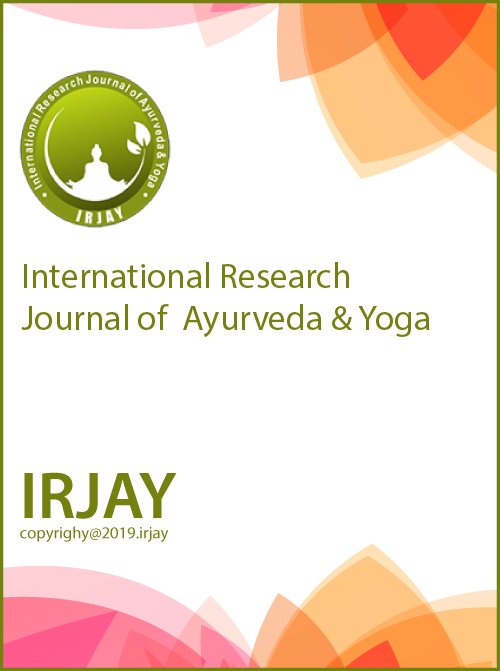A Conceptual Study and Significance of Oja According to Ayurveda
DOI:
https://doi.org/10.48165/IRJAY.2023.61108Keywords:
Bala, Health, Immunity, Ojas, Preventive Health, VyadhikshamatvaAbstract
Ayurveda, renowned as the science of life, is dedicated to preserving the well-being of living organisms by both preventing and treating illnesses. Central to Ayurvedic treatment (Chikitsa) is principles outlined in its literature, including the concepts of Ojas and Vyadhikshamatva. Ojas, situated in the heart (hridaya), extend throughout the body, governing its processes. The presence of Ojas is fundamental for the sustenance of life, aligning various bodily states, and preventing destruction. This principle is crucial in the body’s defense against disease-causing agents, halting pathogenesis. Ayurvedic literature explicates Ojas as essence of all Dhatus, representing Bala (strength) of each body part. Ojas is likened to Bala, providing physical, mental, and immunological resistance against ailments. Vyadhikshamatva, the body’s capacity to ward off illness, parallels the contemporary concept of immunity in science. Ojas, as a vital force, ensures the body’s survival and alignment of various states when present. It serves as the cornerstone for the body’s resilience against diseases. Vyadhikshamatva, akin to modern immunity, safeguards against harmful infections. The alignment of Ayurvedic principles with contemporary scientific concepts establishes the relevance of Ojas and Vyadhikshamatva in maintaining health and preventing diseases. Recognizing Ojas as the essence of Dhatus underscores its role in physical, mental, and immunological strength. Incorporating these principles into health applications, particularly in addressing immune disorders, can offer holistic approaches in line with Ayurvedic wisdom. Understanding and harnessing Ojas and Vyadhikshamatva could prove instrumental in developing Ayurvedic remedies for enhancing immunity, promoting overall well-being.
Downloads
References
Shastri RD. Charak Samhita, Part 1, Sutrasthana. Ch. 30., Verse 24. Varanasi: Chaukhambha Bharti Academy; 2003.
Gupta GK, editor. Ayurvediya Kriya Sharirvigyana. 1st ed., 2nd Paper 2nd Volume., Ch. 11. Meerut: Uttkarsha Publication; 2016. p. 86. 3. Paradakara VH, editor. Ashtanga Hrudaya of Vagbhata, Sutrasthana.
Ch. 1. Verse 37-39. Varanasi: Chawkhambha Orientalia; 2009. 4. Gupta GK, editor. Ayurvediya Kriya Sharirvigyana. 1st ed., 2nd Paper 2nd Volume. Ch. 1. Meerut: Uttkarsha Publication; 2016.
Shastri RD. Charak Samhita, Part 1, Sutra Sthana. Ch. 17. Verse 74. Varanasi: Chaukhambha Bharti; 2003.
Gupta GK, editor. Ayurvediya Kriya Sharirvigyana. 1st ed., 2nd Paper 2nd Volume. Ch. 11. Meerut: Uttkarsha Publication; 2016. p. 107. 7. Shastri RD, Upadhyaya YN, Pandey GS, editors. Charak Samhita,
Part 1, Sharir Sthana. Ch. 2. Verse 10. Varanasi: Chaukhambha Bharti Academy; 2003.
Shastri RD, Upadhyaya YN, Pandey GS, editors. Charak Samhita, Part 1, Sharir Sthana. Ch. 7. Verse 16. Varanasi: Chaukhambha Bharti Academy; 2003.
Shastri RD, Upadhyaya YN, Pandey GS, editors. Charak Samhita, Part 1, Sutra Sthana. Ch. 30. Verse 9-11. Varanasi: Chaukhambha Bharti Academy; 2003.
Shastri KA, editor. Dhanwantari Sushruta, Sushrutasamhita edited with Hindi Ayurveda Tattva Sandeepika Hindi Commentary, Sutrarsthana. Ch. 15. Verse 20. Varanasi: Chaukhambha Sanskrit Sansthan; 2009.
Shastri RD. Charak Samhita, Part 1, Chikitsa Sthana. Ch. 3. Verse 116. Varanasi: Chaukhambha Bharti Academy; 2003.
Paradakara VH, editor. Ashtanga Hrudaya of Vagbhata. Sutrasthana. 9th ed., Ch. 1. Verse 37-39. Varanasi: Chawkhambha Orientalia; 2009. 13. Gupta GK, editor. Ayurvediya Kriya Sharirvigyana. 2nd Paper., Vol. 2., Ch. 11. Meerut: Uttkarsha Publication; 2016. p. 96. 14. Gupta GK, editor. Ayurvediya Kriya Sharirvigyana. 1st ed., Vol. 2., 2nd Paper., Ch. 11. Meerut: Uttkarsha Publication; 2016.
Shastri RD. Charak Samhita, Chikitsasthana. Ch. 8. Verse 40. Varanasi: Chaukhambha Bharti Academy; 2003.

